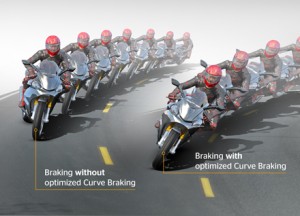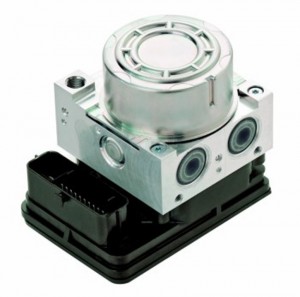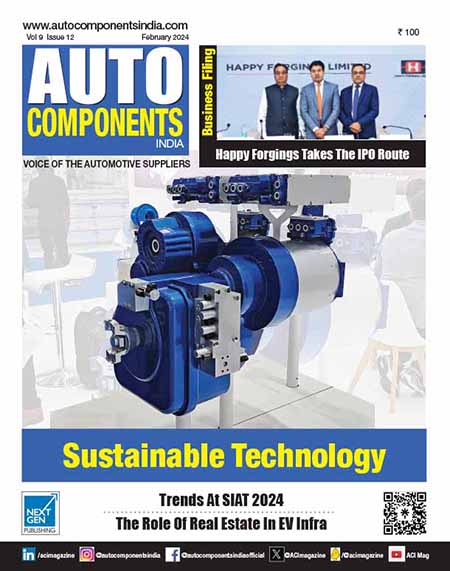Continental Automotive Components India (P) Limited develops intelligent technologies for transporting people and their goods. As a reliable partner, the international automotive supplier, tyre manufacturer and industrial partner provides sustainable, safe, comfortable, individual, and affordable solutions. In 2014, the corporation generated sales of approximately Euro 34.5 billion with its 5 divisions, Chassis & Safety, Interior, Powertrain, Tyre, and ContiTech. Continental currently employs approximately 200,000 people in 53 countries. Raghav Gulur, Head of Technical Center India (TCI), Continental Automotive Components India (P) Ltd. elaborates Leon Martin Ray, on the several product and technology initiatives taken by the company to enhance the safety component of vehicles.
The Chassis & Safety Division develops and produces integrated active and passive driving safety technologies as well as products that support vehicle dynamics. The product portfolio ranges from electronic and hydraulic brake and chassis control systems to sensors, advanced driver assistance systems, airbag electronics and sensors as well as electronic air suspension systems all the way to windscreen washer systems and headlight cleaning nozzles. This division employs more than 38,000 people worldwide and generated sales of approximately Euro 7.5 billion in 2014. Edited excerpts:
Q: What is the current status of the company’s efforts to make vehicles safer?
Gulur: The direction is clear: the future of mobility will lead to fully automated driving. Integrated active and passive safety technologies and products that support vehicle dynamics are providing for ever more safety and comfort. Electronics is becoming increasingly more intelligent and thus create the best conditions for the realisation of Continental’s Vision Zero, the vision of accident-free driving. The Chassis & Safety Division at Continental summarises its contribution as ‘Safe and Dynamic Driving towards Vision Zero’. The process through which we enable this is described by our slogan – SensePlanAct.
The terms Sense, Plan, Act define the fields in which Continental’s chassis and safety products significantly determine driving as such. SensePlanAct stands for a continuous chain of effects that connects all the products and runs like a golden thread through all our activities. We very visibly convey this thread to the areas where everything gets developed and produced with this division comes into play on the road. Sense, Plan, Act comprises integrated active and passive safety technologies that save lives – plus products for enhanced vehicle dynamics. To elaborate further, the ‘eye’ stands for products that are responsible for the perception (Sense) of the vehicle state and its environment, such as our innovative sensors for pedestrian protection, wheel speed sensors, camera, short and long range radars. The ‘brain’ is a symbol used for the derivation of possibilities for action and necessary decisions (Plan), as they are made by various electronic control units. ‘Foot and pedal’ are depicted as the final icon a representative of all those innovations that lead to an action to be performed (Act) that is a direct intervention in the control of the vehicle.
Q: Has the company introduced any vehicle safety-enhancing product for India?
Gulur: India tops the list of nations in total number of road deaths and a significant part of these accidents involving motorcycles. According to an accident research of the German automobile club (ADAC), around a fifth of all motorcycle accidents could have been prevented if the motorbike had been fitted with an anti-lock brake system (ABS). Just like cars, it is also important for motorcycles to remain stable and steerable during a panic brake situation. In 2010 we were the first to introduce ABS in an Indian motorcycle – in TVS Apache. To improve the active safety of motorcycles, Continental has recently expanded its range of electronic brake systems by introducing a one-channel ABS for smaller motorcycles and scooters. Based on its proven ABS technology for passenger cars, this technology in break system was developed especially for cost-sensitive markets such as Asia, where two-wheelers are equipped only with a hydraulic brake on the front wheel. The one-channel ABS is the newest addition to Continental’s portfolio of motorcycle systems currently in series production: motorcycle integral brake systems and motorcycle anti-lock brake systems (two-channel ABS).
Q: How does this work?
Gulur: With a box volume of significantly less than 300 cubic centimeters and weighing roughly 420 grams the motorcycle ABS is very light and can be easily applied to suit the widest range of motorcycle and scooter models. ABS control of the front wheel stops it from locking up even during a panic brake by the driver and prevents a fall. A wheel speed sensor constantly monitors the front wheel’s turning speed and from this the algorithms in the control unit calculate whether braking could potentially cause the front wheel to lock up. If so, the system will reduce the brake pressure, thus preventing loss of directional stability and road holding.
Q: Isn’t this applicable for braking on curves too?
Gulur: Yes, there is a new function called optimised curve braking that prevents wheels from locking when braking on curves. Up until now, the anti-lock brake systems (ABS) for motorcycles have been designed to maintain stability during straight-line braking. Brakes must be applied carefully on curves in order to avoid an abrupt fall. The system takes account of the fact that a motorcycle banks during curves. The ABS kicks in more gradually, modulating braking pressure more smoothly to improve handling in such situations. The motorcycle integral brake system makes sure that brake pressure is applied to both the front and rear wheel in ideal proportion. The result is greater overall stability. The motorcycle translates a rider’s braking intention without a radical shift in weight– a prerequisite for dynamic handling and enjoyment coupled with a reassuring sense of safety. It is particularly sensitive to lift-off detection for the rear wheel for optimum deceleration and stability and electronic traction control steps in whenever a motorcycle threatens to get out of control due to excess speed, extreme banking, or too much slip.
Q: Has this been applied for scooters too?
Gulur: We have used the one-channel ABS to increase the driving safety of Piaggio Group’s Vespa Primavera and Sprint. The Vespa GTS 300, the Piaggio Beverly, the Vespa 946, and the Piaggio X10 are available with a two-channel ABS while the Piaggio MP3 is equipped with a three-channel ABS.
Q: What role does research play in this move towards safety?
Gulur: The Chassis & Safety Division’s approach is to be ‘in the market for the market’. This is also reflected by our R&D footprint for electronic brake systems for motorcycles with locations in Europe, India, China, Japan, the USA and Brazil. In the beginning of 2015 we expanded our R&D footprint in India and inaugurated a new Technical Center India (TCI) in Bangalore to meet the increasing demand for engineering and software development skills to support global R&D projects as well as local customers. Today, our engineers in India are developing one-channel ABS solutions for two-wheelers alongside highly sophisticated technologies for domains such as advanced driver assistance systems. Adding value with its understanding of the local market and customers, TCI is quickly emerging as a Center of Competence for two-wheeler markets and for customised products for the BRIC countries.
Q: Could you elaborate about the new surround view camera technology?
Gulur: A joint research project with the Allianz Center for Technology showed that driver assistance systems can reduce damage caused during parking and maneuvering. As such, Continental has developed a driver assistance function based exclusively on this camera. The back-up assist helps to avoid collisions while reversing at low speeds. The technical basis is the integrated surround view camera technology in the demonstration vehicle. It encompasses the entirety of the vehicle’s surroundings in a 360-degree view and can be used for various functions. Until now, fish eye camera technology was used to assist drivers while parking by showing the vehicle from a bird’s eye perspective and the vehicle path while reversing. This allows drivers to better estimate the distance to objects in their surroundings. We also see additional applications for the surround view systems. These include automatic brake intervention while reversing, a cross traffic assistant and automated parking.
Four fish eye cameras are built into the prototype – one at the front in the grill, one at the rear and one at the base of each side mirror. Each camera has an aperture angle of more than 180 degrees, making it possible to have a 360-degree view of the vehicle’s surroundings without any gaps. Objects in the vehicle’s path which obstruct the space needed for maneuvering are recognised in the image analysis. Continental uses the image analysis from the rear camera for the back-up assist in order to avoid a collision with objects behind the vehicle. The electronic control unit for the surround view system is connected to the vehicle’s electronic brake system and automatically brakes when a collision with a recognised object cannot otherwise be avoided. Another strength of the camera technology is its ability to not only recognise objects but also classify objects, for example as pedestrians or cyclists.














